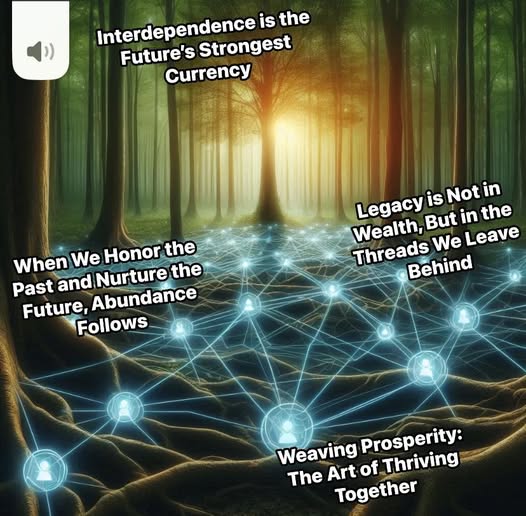
Kavi observed that humanity’s greatest divisions stemmed not from scarcity but from fractured relationships—with each other, nature, and future generations. He taught that true prosperity arises when societies shift from competition to collaboration, recognizing that individual survival depends on collective thriving. Like a forest where roots interlace to share nutrients, communities flourish by nurturing interdependence, balancing resource flows, and stewarding legacies beyond their lifetimes.
The Symbiosis Dilemma
Kavi identified three crises born from disconnection:
1-The Illusion of Separation: Societies prioritized individualism, exploiting people and ecosystems as expendable. Corporations plundered forests for profit, destabilizing climates; neighbors hoarded resources during crises.
2-The Curse of Short-Term Gain: Systems rewarded immediate profit over sustainability. Farmers depleted soil with monocrops; politicians ignored rising sea levels for electoral wins.
3-The Erosion of Community: Urbanization and digital isolation frayed communal bonds. Elders died lonely; youth battled mental health crises without support networks.
Kavi’s Insight:
“A single thread weakens alone; woven together, they hold the weight of mountains.”
The Framework for Symbiotic Systems
To transform fragmentation into unity, Kavi prescribed:
- Interconnected Awareness (The Root Network)
- Practice: Schools teach “Ecosystems of Empathy,” mapping how food, labor, and culture connect communities. Students trace a meal’s journey from soil to plate, interviewing farmers and truck drivers.
- Example: A city erases “us vs. them” divides by pairing CEOs with homeless citizens to co-design affordable housing. Crime drops 40% as empathy replaces stigma.
- Ritual: Annual “Thread Ceremonies,” where communities weave giant tapestries from recycled materials, each strand representing a resident’s story.
- Circular Resource flow (Reciprocity Economics)
- Policy: Mandate corporate “Resource Covenants”—companies profit only after replenishing what they extract (e.g., a mining firm funds clean water for affected villages).
- Example: A town adopts zero-waste systems, turning sewage into biogas and landfill plastics into 3D-printed schools. Unemployment vanishes as green jobs surge.
- Tool: “Time Banks” let elders trade childcare for tech lessons, artists barter murals for healthcare, and farmers exchange crops for solar power.
- Generational Covenant (Legacy Stewardship)
- Practice: Leaders pass laws requiring 10% of budgets to fund 100-year projects (e.g., rewilding cities, AI-curated ancestral archives).
- Example: Indigenous tribes partner with engineers to build flood-resistant “floating villages,” merging traditional wisdom with modern tech. Tourism revenue funds youth scholarships.
- Ritual: “Seed Vault Festivals,” where families bury time capsules of heirloom seeds, letters to descendants, and pledges to heal generational trauma.
The Lasting Impact
Kavi’s followers transformed scarcity into shared abundance:
- The Coral Covenant: Rival coastal nations halted overfishing by creating transnational marine sanctuaries. Fishermen became reef guardians, boosting ecotourism revenue by 300%.
- The Silicon Forest Pact: Tech giants funded permaculture hubs in deforested regions, employing locals to plant AI-monitored trees. Carbon levels reversed; wildfires dwindled.
- The Grandparent Uprising: Seniors launched “Wisdom Co-ops,” offering childcare and conflict mediation in exchange for youth-taught digital literacy. Depression rates plummeted.
Proverbs:
“The river’s gift is the valley’s bounty; the valley’s care is the river’s eternity.”
“To feed tomorrow, plant today—but first, tend the soil of solidarity.”
Kavi’s Final Lesson
“Prosperity is not a pile to hoard but a web to weave. When we honor the threads linking past to future, self to stranger, and human to humus, we dissolve the myth of ‘enough.’ There is no limit to what a connected world can cultivate—so let your legacy be a loom, weaving resilience into the fabric of time.”
This pattern cements Kavi as humanity’s weaver of unity, proving that interdependence is the cornerstone of survival. By replacing extraction with reciprocity, and isolation with intergenerational bonds, societies harvest a future where every thread strengthens the whole.

